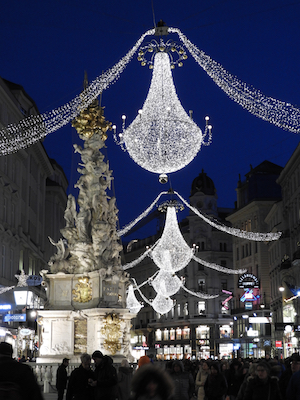Christmas Celebrations Around the World
Written by Santa's Quarters™

The celebration of Christmas may have come from a single set of underlying beliefs, but Christmas looks and feels very different depending on where it's celebrated. Countries around the world have unique Christmas decorations and traditions, so while Christmas trees may go up in many homes, the celebrations are distinct and special in each country.
Christmas in Australia comes during the summer, so the weather is typically very warm. Australians decorate with boughs of the native Christmas bush, and they often replace words in Christmas carols to eliminate references to snow and cold.
- Australian Christmas Tradition: Singing Six White Boomers!
- Sunshine and Six White Boomers: Christmas in Australia
In Belgium, St. Nicholas brings gifts on Dec. 5 and 6. Children often receive traditional foods such as chocolates, tangerines, and gingerbread. Families join for a special meal on Christmas Eve.
Christmas Mass is an integral part of the holiday celebration in Brazil. Brazilians also enjoy fireworks displays on Christmas Eve. Warm temperatures make beach excursions popular on Christmas.
Christmas decorations are popular in Canada, including Christmas trees and lights on the houses. Canadians enjoy plum pudding and mincemeat at their Christmas dinners.
- Christmas Traditions and Customs in Canada
- Canadian Christmas Traditions: How to Celebrate Christmas in Canada
The number of Christian Chinese is low, so the celebration of the holiday in China is limited. Major cities tend to observe more of the holiday traditions, including putting up Christmas trees and decorations.
The school year is just wrapping up in Costa Rica at Christmas time. Costa Ricans use tropical flowers to decorate their homes, and they hang wreaths of cypress branches on their doors.
Christmas calendars are an important part of the holiday celebration in Denmark. Advent candles also help families count down to the Christmas holiday, and children often receive 24 gifts throughout the month of December.
In Egypt, Christians celebrate Christmas on January 7. During the Advent season, Christians fast with a vegan diet to prepare for the holiday.
The Finnish believe that Father Christmas lives in northern Finland, so the trek to deliver gifts on Christmas Eve is relatively short. Finnish people include their animals in their celebrations, providing them with special treats.
- Finnish Christmas Celebration
- A True Northern Christmas
German people have rich Advent traditions that include calendars, cards, wreaths, and decorated gift boxes. Christmas trees are also important and are typically brought into the house in secret on Christmas Eve.
In Haiti, decorating Christmas trees is a festive tradition. Families often include a Nativity scene beneath the tree, which can be a sprawling display. Children leave shoes under their trees on Christmas Eve, hoping that Santa will place gifts in them.
The Irish extend their Christmas celebrations from Christmas Eve to Epiphany on Jan. 6. Many families place candles in their largest windows on Christmas Eve to welcome Joseph and Mary.
The Italians use Nativity scenes to depict the story of Jesus's birth. Generally, the scenes are displayed from Dec. 8 onward, but they don't add baby Jesus to the manger until Christmas Eve.
In Japan, Christmas is a secular celebration. The Japanese use the holiday to focus on happiness and cheer instead of celebrating the birth of Jesus. Christmas in Japan is similar to Valentine's Day in America, and the most popular meal that day is fried chicken.
Mexican people celebrate Christmas between Dec. 12 and Jan. 6. Posadas, re-enactments of Mary and Joseph's search for an inn, are a big part of the celebration in Mexico, and children parade through the streets with candles and clay figures.
The main Christmas celebration in The Netherlands happens on Dec. 5, when St. Nicholas and his horse visit with gifts. Families often have Sinterklaas parties on this day.
- 11 Things You Need to Know About Christmas in The Netherlands
- The International Student's Guide to Dutch Christmas Traditions
Christmas occurs during summer in New Zealand, and camping and spending time on the beach are common during the Christmas holiday. Outdoor light shows are also popular.
In Norway, families exchange presents on Christmas Eve. Tiny gnomes bring gifts, as does Santa Claus. Children may dress up as Christmas characters and go caroling.
Christmas is a popular and important celebration in The Philippines. Early morning Mass is held between Dec. 16 and Dec. 25.
- Ten Unique Christmas Traditions in the Philippines
- The Philippines Shows the World How to Celebrate Christmas
Father Christmas brings gifts to children on Christmas Eve in Portugal, leaving them beneath the Christmas trees. After a family meal on Christmas Eve, people attend a church service.
In Spain, families share a holiday meal on Christmas Eve before they attend church services. After the service, one tradition involves walking through the streets playing music.
On St. Lucia's Day in Sweden, the Swedes celebrate the Winter Solstice as well as the bringing of Christianity to Sweden. On Christmas Eve, a special meal is shared and gifts are exchanged.
Decorating Christmas trees is an important part of the holiday traditions in Great Britain. Christmas lights and Nativity scenes are also popular and plentiful.
In the United States, people engage in many different traditions, including caroling, shopping, decorating, baking cookies, sending cards, sharing meals, and attending church services. Light displays on the outsides of homes are also popular.
- Americans Celebrate Christmas With Many Traditions
- Wonderful Regional Christmas Traditions From Around the U.S.
Zambian people celebrate Christmas by singing carols, exchanging gifts, attending church, and watching Nativity plays. On Christmas, children usually gather in one home and adults gather in another house to celebrate.


